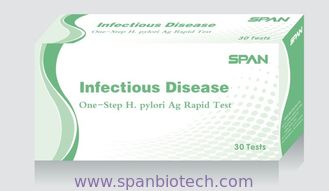|
|
One-Step H.Pylori Ag Rapid Diagnostic Test Uncut Sheet
|
Product Details:
Payment & Shipping Terms:
|
| Specificity: | 100% |
|---|
One-Step H.Pylori Ag Rapid Test Uncut Sheet
INTENDED USE
The Helicobacter-Pylori antigen rapid test kit (stool) is a rapid visual immunoassay for the qualitative detection of helicobacter pylori antigen in human stool specimens. This kit is used as an aid in the diagnosis of H. pylori infection.
INTRODUCTION
Helicobacter pylori (also known as Campylobacter pylori) as a spiral-shaped gram negative bacteria which infects the gastric mucosa. H. pylori to causes several gastro-enteric diseases such as non-ulcerous dyspepsia, gastric and duodenal ulcer, active gastritis and can even increase the risk of stomach adenocarcinoma.
The epidemiologic study shows that more than 50% of the world's population is infected by H. pylori strains. Infection is more prevalent in developing countries. The lowest infection rate is 20%, and the highest infection rate can be 90% in developing countries. H. pylori strains is the major reason to cause chronic gastritis and gastric ulcers, 80%-90% chronic gastritis patients and 95%-100% gastric ulcers patients are infected by H. pylori strains. So the detection and treatment of H. pylori strains infection is very important.
At present several invasive and non-invasive approaches are available to detect this infection state. Invasive methodologies require endoscopy of the gastric mucosa with histologic, cultural and urease investigation, which are expensive and require some time for diagnosis. Alternatively, non-invasive methods are available such as breath tests, which are extremely complicated and not highly selective, and classical ELISA and immunoblot assays. This Kit belongs to non-invasive approach.
PRINCIPLE
This kit is designed to detect helicobacter pylori through visual interpretation of the color development in the internal strip based on the specific The membrane was immobilized with antibodies-specific on the test well (T) and corresponding antibodies on the control well(C) .
During testing, the specimen is added to the sample region (S) and reacts with anti-H. pylori antibodies conjugated to colored particles and precoated onto the sample pad of the test. Then, the mixture migrates through the membrane by capillary effect and interacts with reagents on the membrane. If there is sufficient H. pylori antigens in the specimen, a colored band will form at the test well (T) of the membrane, and this colored band indicates a positive result, while its absence indicates a negative result. A colored band at the control well(C) serves as a procedural control, indicating that the proper volume of specimen has been added and membrane wicking has occurred.
KIT COMPONENTS
|
COMPONENTS |
DETAIL |
QUANTITY |
|
Individual packed test cassette |
Each cassette contains a strip with colored conjugates and reactive reagents precoated at the corresponding position. |
20 pieces |
|
Specimen tube with extracting solution |
Main Ingredients: NaCl , EDTA, sodium azide and purified Water |
2ml*20 |
|
Package insert |
For operating instruction |
1pc |
MATERIALS REQUIRED BUT NOT PROVIDED
|
Timer |
For timing use |
STORAGE AND VALIDITY
· The kit should be stored at 2-30°C in a cool and dry place, protected from light
· The validity duration is 12 months
· Do not freeze.
· Do not use after the expiration date indicated on the package.
SPECIMEN COLLECTION
· Sufficient specimen should be collected and extracted.
· No age limitation to specimen providers
· No limitation to specimen collection time.
· Perform testing immediately after specimen collection. Do not leave specimens at room temperature for prolonged periods. Specimens may be stored at 2-8°C for up to 72 hours or frozen at -10°C for long- term storage.
· Avoiding repeated freezing and unfreezing. Fresh specimen is recommended
· Specimen can not be used for test once stored more than 72 hours at 2-8°C and repeated freezing and unfreezing more than three times.
PROCEDURE
Read the entire procedure carefully prior to testing. Keep test kit and specimen at room temperature (15-30°C) before use.
1. Unscrew the specimen tube with extracting solution, collect specimen by inserting the collection stick into the stool to collect the specimen with diameter approximate to 5mm (equivalent to 1/4 of a green bean).
2. Put the collection stick back into the tube carefully and screw the cap tightly.
3. Press the bottom of specimen tube strongly; fully shake to mix the specimen and the extraction buffer. Then keep the specimen stationary in two minutes before use.
4. Take the test cassette out of its sealed pouch, and place it on a clean, dry and flat surface.
5. Unscrew the top cap of extracting tube. Hold the tube vertically and dispense 2-3 drops of solution into the sample region (S) of the test cassette. The unsealed test cassette should be performed within one hour.
6. Wait for the colored band(s) to appear. The result should be read right after 15minutes. Do not interpret the result after 20 minutes.
Span Biotech Ltd.
Tel: +86(755)89589611
Cell Phone:+8618823462100(WhatsApp)
Web:www.spanbio.com
Contact Person: Ms. Anna Lee
Tel: +86-755-89589611
Fax: 86-755-89580096
-
HIV1/2/O Tri-Lines Rapid Test Uncut Sheet(WB/S/P)
-
H.Pylori Ag Feces Rapid Test Uncut Sheet (Cassette/Strip)
-
Monkeypox Virus Antigen Rapid Test Kit
-
One-Step Salbutamol Rapid Diagnostic Test Uncut Sheet
-
One-Step Malaria Pf/Pan Ag Rapid Diagnostic Test Uncut Sheet WB
-
Giardia Ag Feces Rapid Diagnostic Test




